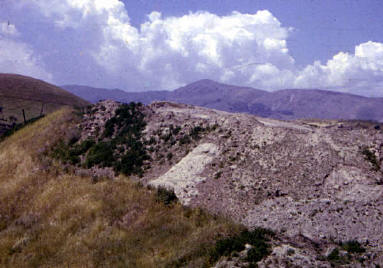|
Interpretation
Facts do not speak for themselves they must be interpreted.
Each scientist is obligated to interpret his facts (data), though two or more
scientist may use the same data to arrive at different conclusions. For example,
two explanations have been given for the origin of San Francisco Bay, and each
explanation is based on identical data.
 |
| An overview of the Irvington Site with Mission
Peak in the background (1950). |
The following account of geologic events at Irvington is an
interpretation of Savage’s data. How well do you follow his reasoning? Can you
visualize the changing scenes?
-
Deposition
of the mid-Pleistocene clay, sand, gravel, and bones of mammals and of other
forms of life by streams or by the wandering branches of one stream flowing
from the south.
-
Lowering
of the elevation of the drainage basin, which reduced the speed of running
waters, resulting in the deposition of finer sediments.
-
Mild
earth movements which tilted the beds 20 degrees to 25 degrees
northeastward.
-
Lowering
of the entire Irvington area to base level by the stream or streams that
previously deposited the beds.
-
Movement
along the Hayward fault, causing the beds on the west, toward the present
Bay, to be lowered at least 300 feet.
-
Building
up of Mission Creek, resulting from the erosion of the earlier beds the
mid-Pleistocene beds by the increasing stream flow. Beginning of stream
erosion into the fault scarp.
-
Lowering
to base level and filling in of the San Francisco Bay plain. Continued
erosion of the fault scarp by the small streams that began their work in
stage 6.
-
Later
movements along the Hayward Fault, perhaps both vertical and horizontal are
causing small faults in the Irvington beds.
-
Small
present-day streams continue to remove sediments from the Irvington hills
and deposit them on the plain to the west. The streams are aided in this
process by man, who removes sediments with machinery.
|